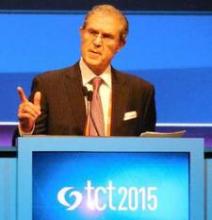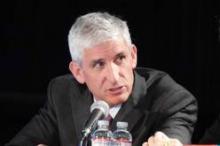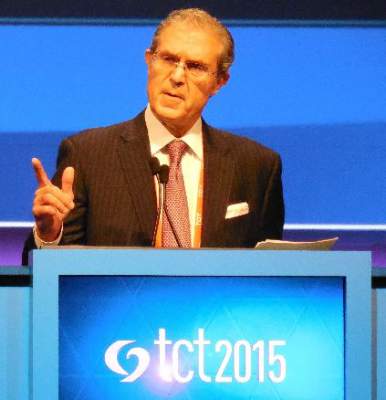User login
SAN FRANCISCO – The first bioresorbable vascular scaffold to finish a U.S. pivotal trial met its prespecified noninferiority endpoint, compared with the best-available metallic drug-eluting stent, putting the Absorb scaffold in good position to soon reach the U.S. market.
But, as expected, the results from the pivotal ABSORB III randomized controlled trial also left unaddressed the question of whether bioresorbable vascular scaffolds (BVS) actually offer patients any benefit above the best metallic drug-eluting stent comparator. That part won’t be answered for several more years, until results from an expanded, prospective group of 5,000 randomized patients are followed for something like 5 years, study researchers said.
Until then, favoring the Absorb stent over a metallic model will involve “a leap of faith,” admitted Dr. Dean J. Kereiakes, coprincipal investigator of the trial, who reported the ABSORB III results at the Transcatheter Cardiovascular Therapeutics annual meeting.
“There was no expectation that Absorb would be superior at 1 year,” emphasized Dr. Gregg W. Stone, chairman of the trial during discussion of the results. “The thought is that, as the Absorb BVS disappears over several years, then we’ll start to see improved outcomes,” said Dr. Stone, professor and director of cardiovascular research and education at the Center for Interventional Vascular Therapy of Columbia University in New York.
“The best metallic drug-eluting stents have a total lesion failure rate of about 17% after 5 years, with about half due to the device,” commented Dr. Daniel I. Simon, professor and chief of cardiovascular medicine at University Hospitals Case Medical Center in Cleveland. “This is an unmet need to address. We need to do better for patients, and this is a tool to do that,” he said during a press conference at the meeting.
The ABSORB III trial enrolled 2,008 patients with stable or unstable angina undergoing percutaneous coronary intervention at 193 centers in the United States and Australia. Patients’ coronary lesions received treatment with either the Absorb BVS or the Xience V everolimus-eluting cobalt-chromium stent. The primary endpoint was a test for noninferiority by the Absorb BVS for target-lesion failure after 1 year, defined as the combined rate of cardiovascular death, target-vessel MI, or ischemia-driven target-lesion revascularization.
The 1-year rates were 7.8% in 1,312 Absorb recipients who completed the 12-month follow-up and a 6.1% rate in 677 control patients. The upper statistical limit of the 1.7%-between group difference fell within the 4.5% prespecified difference for noninferiority, Dr. Kereiakes reported at the meeting, sponsored by the Cardiovascular Research Foundation. Concurrent with his report the results appeared online (N Engl J Med. 2015 Oct 12;doi: 10.1056NEJMoa1509038).
Although the results met the study’s primary endpoint, the outcomes showed that the Absorb BVS numerically underperformed the comparator metallic stent by several individual efficacy and safety parameters, including target-vessel MI and stent thrombosis, but none of the differences were statistically significant. Dr. Kereiakes dismissed these as “small, insignificant differences for low-frequency events that were underpowered to show differences.” The results also showed no suggestion that the incidence of angina during 1-year follow-up differed between the two treatment arms, indicating that prior evidence for an angina-reducing benefit with BVS treatment that had been seen in smaller studies had been misleading, Dr. Stone acknowledged.
Dr. Kereiakes stressed that the noninferiority outcome occurred in procedures performed by operators who largely used BVS for the first time. Despite that, the procedural success rate with the BVS was similar to that of the metallic stent. Procedures using a BVS averaged 4 minutes longer than did placement of the metallic stent.
One additional analysis presented by Dr. Kereiakes provided an important lesson about the danger of using the Absorb BVS in coronary arteries less than 2.5 mm in diameter. Even though the study protocol specified not treating vessels less than 2.5 mm in diameter, case records showed that 19% of the BVS target vessels had diameters of 2.25 mm or less, noted Dr. Kereiakes, medical director of the Christ Hospital Heart and Vascular Center in Cincinnati. Within this subgroup, the rate of target-lesion failure ran 13% with BVS and 8% with the metallic stent, while in the 80% of vessels that were properly sized, the primary endpoint occurred in 7% and 6% respectively.
“The lesson is clear: This BVS does not perform well in small vessels when operators do not use the correct methodology with aggressive postdilitation,” commented Dr. Martin B. Leon, director of the Center for Interventional Vascular Therapy of Columbia University in New York.
ABSORB III was sponsored by Abbott Vascular, which markets the Absorb BVS. Dr. Kereiakes has been a consultant to Abbott Vascular as well as to HCRI, Boston Scientific, Svelte, Janssen, and Sanofi-Aventis, and he holds equity interest in Ablative Solution. Dr. Stone has received grant support and consultant fees from Abbott Vascular and has been a consultant to 12 other companies and holds equity options in 8t companies. Dr. Simon has received research grants from and has been a consultant to Medtronic and a consultant to Cordis, Merck, and Janssen. Dr. Leon had no relevant disclosures.
On Twitter @mitchelzoler
SAN FRANCISCO – The first bioresorbable vascular scaffold to finish a U.S. pivotal trial met its prespecified noninferiority endpoint, compared with the best-available metallic drug-eluting stent, putting the Absorb scaffold in good position to soon reach the U.S. market.
But, as expected, the results from the pivotal ABSORB III randomized controlled trial also left unaddressed the question of whether bioresorbable vascular scaffolds (BVS) actually offer patients any benefit above the best metallic drug-eluting stent comparator. That part won’t be answered for several more years, until results from an expanded, prospective group of 5,000 randomized patients are followed for something like 5 years, study researchers said.
Until then, favoring the Absorb stent over a metallic model will involve “a leap of faith,” admitted Dr. Dean J. Kereiakes, coprincipal investigator of the trial, who reported the ABSORB III results at the Transcatheter Cardiovascular Therapeutics annual meeting.
“There was no expectation that Absorb would be superior at 1 year,” emphasized Dr. Gregg W. Stone, chairman of the trial during discussion of the results. “The thought is that, as the Absorb BVS disappears over several years, then we’ll start to see improved outcomes,” said Dr. Stone, professor and director of cardiovascular research and education at the Center for Interventional Vascular Therapy of Columbia University in New York.
“The best metallic drug-eluting stents have a total lesion failure rate of about 17% after 5 years, with about half due to the device,” commented Dr. Daniel I. Simon, professor and chief of cardiovascular medicine at University Hospitals Case Medical Center in Cleveland. “This is an unmet need to address. We need to do better for patients, and this is a tool to do that,” he said during a press conference at the meeting.
The ABSORB III trial enrolled 2,008 patients with stable or unstable angina undergoing percutaneous coronary intervention at 193 centers in the United States and Australia. Patients’ coronary lesions received treatment with either the Absorb BVS or the Xience V everolimus-eluting cobalt-chromium stent. The primary endpoint was a test for noninferiority by the Absorb BVS for target-lesion failure after 1 year, defined as the combined rate of cardiovascular death, target-vessel MI, or ischemia-driven target-lesion revascularization.
The 1-year rates were 7.8% in 1,312 Absorb recipients who completed the 12-month follow-up and a 6.1% rate in 677 control patients. The upper statistical limit of the 1.7%-between group difference fell within the 4.5% prespecified difference for noninferiority, Dr. Kereiakes reported at the meeting, sponsored by the Cardiovascular Research Foundation. Concurrent with his report the results appeared online (N Engl J Med. 2015 Oct 12;doi: 10.1056NEJMoa1509038).
Although the results met the study’s primary endpoint, the outcomes showed that the Absorb BVS numerically underperformed the comparator metallic stent by several individual efficacy and safety parameters, including target-vessel MI and stent thrombosis, but none of the differences were statistically significant. Dr. Kereiakes dismissed these as “small, insignificant differences for low-frequency events that were underpowered to show differences.” The results also showed no suggestion that the incidence of angina during 1-year follow-up differed between the two treatment arms, indicating that prior evidence for an angina-reducing benefit with BVS treatment that had been seen in smaller studies had been misleading, Dr. Stone acknowledged.
Dr. Kereiakes stressed that the noninferiority outcome occurred in procedures performed by operators who largely used BVS for the first time. Despite that, the procedural success rate with the BVS was similar to that of the metallic stent. Procedures using a BVS averaged 4 minutes longer than did placement of the metallic stent.
One additional analysis presented by Dr. Kereiakes provided an important lesson about the danger of using the Absorb BVS in coronary arteries less than 2.5 mm in diameter. Even though the study protocol specified not treating vessels less than 2.5 mm in diameter, case records showed that 19% of the BVS target vessels had diameters of 2.25 mm or less, noted Dr. Kereiakes, medical director of the Christ Hospital Heart and Vascular Center in Cincinnati. Within this subgroup, the rate of target-lesion failure ran 13% with BVS and 8% with the metallic stent, while in the 80% of vessels that were properly sized, the primary endpoint occurred in 7% and 6% respectively.
“The lesson is clear: This BVS does not perform well in small vessels when operators do not use the correct methodology with aggressive postdilitation,” commented Dr. Martin B. Leon, director of the Center for Interventional Vascular Therapy of Columbia University in New York.
ABSORB III was sponsored by Abbott Vascular, which markets the Absorb BVS. Dr. Kereiakes has been a consultant to Abbott Vascular as well as to HCRI, Boston Scientific, Svelte, Janssen, and Sanofi-Aventis, and he holds equity interest in Ablative Solution. Dr. Stone has received grant support and consultant fees from Abbott Vascular and has been a consultant to 12 other companies and holds equity options in 8t companies. Dr. Simon has received research grants from and has been a consultant to Medtronic and a consultant to Cordis, Merck, and Janssen. Dr. Leon had no relevant disclosures.
On Twitter @mitchelzoler
SAN FRANCISCO – The first bioresorbable vascular scaffold to finish a U.S. pivotal trial met its prespecified noninferiority endpoint, compared with the best-available metallic drug-eluting stent, putting the Absorb scaffold in good position to soon reach the U.S. market.
But, as expected, the results from the pivotal ABSORB III randomized controlled trial also left unaddressed the question of whether bioresorbable vascular scaffolds (BVS) actually offer patients any benefit above the best metallic drug-eluting stent comparator. That part won’t be answered for several more years, until results from an expanded, prospective group of 5,000 randomized patients are followed for something like 5 years, study researchers said.
Until then, favoring the Absorb stent over a metallic model will involve “a leap of faith,” admitted Dr. Dean J. Kereiakes, coprincipal investigator of the trial, who reported the ABSORB III results at the Transcatheter Cardiovascular Therapeutics annual meeting.
“There was no expectation that Absorb would be superior at 1 year,” emphasized Dr. Gregg W. Stone, chairman of the trial during discussion of the results. “The thought is that, as the Absorb BVS disappears over several years, then we’ll start to see improved outcomes,” said Dr. Stone, professor and director of cardiovascular research and education at the Center for Interventional Vascular Therapy of Columbia University in New York.
“The best metallic drug-eluting stents have a total lesion failure rate of about 17% after 5 years, with about half due to the device,” commented Dr. Daniel I. Simon, professor and chief of cardiovascular medicine at University Hospitals Case Medical Center in Cleveland. “This is an unmet need to address. We need to do better for patients, and this is a tool to do that,” he said during a press conference at the meeting.
The ABSORB III trial enrolled 2,008 patients with stable or unstable angina undergoing percutaneous coronary intervention at 193 centers in the United States and Australia. Patients’ coronary lesions received treatment with either the Absorb BVS or the Xience V everolimus-eluting cobalt-chromium stent. The primary endpoint was a test for noninferiority by the Absorb BVS for target-lesion failure after 1 year, defined as the combined rate of cardiovascular death, target-vessel MI, or ischemia-driven target-lesion revascularization.
The 1-year rates were 7.8% in 1,312 Absorb recipients who completed the 12-month follow-up and a 6.1% rate in 677 control patients. The upper statistical limit of the 1.7%-between group difference fell within the 4.5% prespecified difference for noninferiority, Dr. Kereiakes reported at the meeting, sponsored by the Cardiovascular Research Foundation. Concurrent with his report the results appeared online (N Engl J Med. 2015 Oct 12;doi: 10.1056NEJMoa1509038).
Although the results met the study’s primary endpoint, the outcomes showed that the Absorb BVS numerically underperformed the comparator metallic stent by several individual efficacy and safety parameters, including target-vessel MI and stent thrombosis, but none of the differences were statistically significant. Dr. Kereiakes dismissed these as “small, insignificant differences for low-frequency events that were underpowered to show differences.” The results also showed no suggestion that the incidence of angina during 1-year follow-up differed between the two treatment arms, indicating that prior evidence for an angina-reducing benefit with BVS treatment that had been seen in smaller studies had been misleading, Dr. Stone acknowledged.
Dr. Kereiakes stressed that the noninferiority outcome occurred in procedures performed by operators who largely used BVS for the first time. Despite that, the procedural success rate with the BVS was similar to that of the metallic stent. Procedures using a BVS averaged 4 minutes longer than did placement of the metallic stent.
One additional analysis presented by Dr. Kereiakes provided an important lesson about the danger of using the Absorb BVS in coronary arteries less than 2.5 mm in diameter. Even though the study protocol specified not treating vessels less than 2.5 mm in diameter, case records showed that 19% of the BVS target vessels had diameters of 2.25 mm or less, noted Dr. Kereiakes, medical director of the Christ Hospital Heart and Vascular Center in Cincinnati. Within this subgroup, the rate of target-lesion failure ran 13% with BVS and 8% with the metallic stent, while in the 80% of vessels that were properly sized, the primary endpoint occurred in 7% and 6% respectively.
“The lesson is clear: This BVS does not perform well in small vessels when operators do not use the correct methodology with aggressive postdilitation,” commented Dr. Martin B. Leon, director of the Center for Interventional Vascular Therapy of Columbia University in New York.
ABSORB III was sponsored by Abbott Vascular, which markets the Absorb BVS. Dr. Kereiakes has been a consultant to Abbott Vascular as well as to HCRI, Boston Scientific, Svelte, Janssen, and Sanofi-Aventis, and he holds equity interest in Ablative Solution. Dr. Stone has received grant support and consultant fees from Abbott Vascular and has been a consultant to 12 other companies and holds equity options in 8t companies. Dr. Simon has received research grants from and has been a consultant to Medtronic and a consultant to Cordis, Merck, and Janssen. Dr. Leon had no relevant disclosures.
On Twitter @mitchelzoler
AT TCT 2015
Key clinical point: The Absorb bioresorbable vascular scaffold met its prespecified noninferiority primary endpoint in its pivotal U.S. trial.
Major finding: Target-lesion failure occurred in 7.8% of Absorb patients and 6.1% of controls on the best metallic drug-eluting stent.
Data source: ABSORB III, a pivotal randomized controlled trial with 2,008 patients run at 193 centers in the United States and Australia.
Disclosures: ABSORB III was sponsored by Abbott Vascular, which markets the Absorb BVS. Dr. Kereiakes has been a consultant to Abbott Vascular as well as to HCRI, Boston Scientific, Svelte, Janssen, and Sanofi-Aventis, and he holds equity interest in Ablative Solution.




